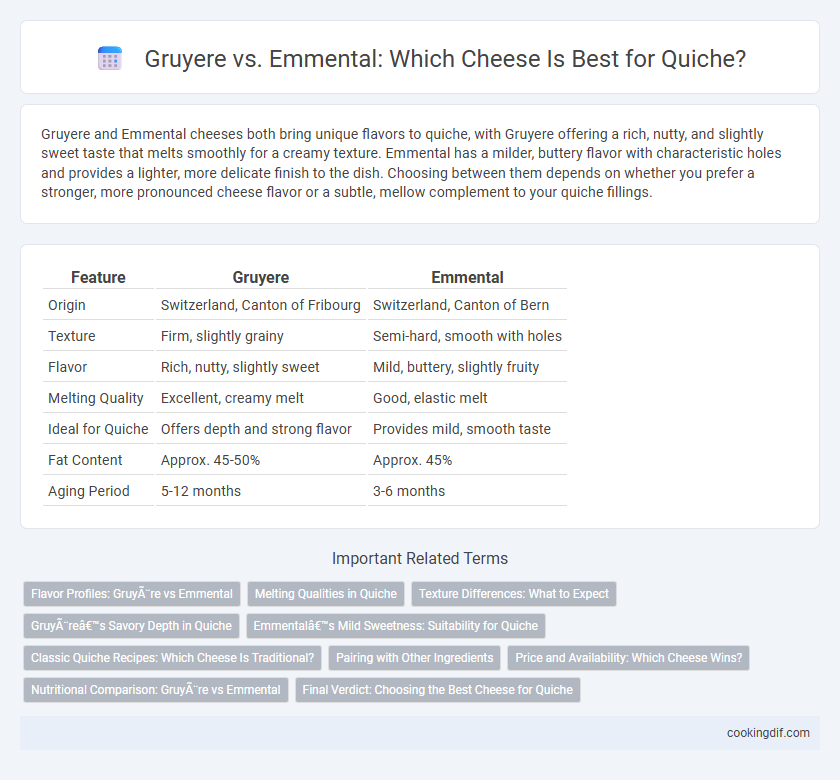Gruyere and Emmental cheeses both bring unique flavors to quiche, with Gruyere offering a rich, nutty, and slightly sweet taste that melts smoothly for a creamy texture. Emmental has a milder, buttery flavor with characteristic holes and provides a lighter, more delicate finish to the dish. Choosing between them depends on whether you prefer a stronger, more pronounced cheese flavor or a subtle, mellow complement to your quiche fillings.
Table of Comparison
| Feature | Gruyere | Emmental |
|---|---|---|
| Origin | Switzerland, Canton of Fribourg | Switzerland, Canton of Bern |
| Texture | Firm, slightly grainy | Semi-hard, smooth with holes |
| Flavor | Rich, nutty, slightly sweet | Mild, buttery, slightly fruity |
| Melting Quality | Excellent, creamy melt | Good, elastic melt |
| Ideal for Quiche | Offers depth and strong flavor | Provides mild, smooth taste |
| Fat Content | Approx. 45-50% | Approx. 45% |
| Aging Period | 5-12 months | 3-6 months |
Flavor Profiles: Gruyère vs Emmental
Gruyere cheese offers a rich, nutty flavor with a slight earthy undertone, enhancing quiche with depth and complexity. Emmental presents a milder, slightly sweet taste with characteristic holes, contributing a creamier texture without overpowering other ingredients. Choosing Gruyere intensifies the savory notes, while Emmental maintains subtlety and balance in quiche recipes.
Melting Qualities in Quiche
Gruyere offers a smooth, creamy melt that enhances the custard texture in quiche, providing a rich, nutty flavor without becoming greasy. Emmental melts more elastically and can create a stringier, lighter texture, contributing a mild, slightly sweet taste but less depth compared to Gruyere. Choosing Gruyere ensures a denser, more cohesive filling, while Emmental works best for a lighter, airier quiche texture.
Texture Differences: What to Expect
Gruyere offers a dense, creamy texture that melts smoothly in quiche, creating a rich and velvety filling. Emmental has a more elastic and slightly springy texture, resulting in a lighter, airier consistency when baked. Choosing Gruyere enhances quiche with a luxurious, thick mouthfeel, while Emmental provides a tender and subtly chewy finish.
Gruyère’s Savory Depth in Quiche
Gruyere cheese imparts a rich, savory depth to quiche, enhancing its flavor with complex nutty and slightly sweet notes. Compared to Emmental, which offers a milder, more elastic texture and a subtle, buttery taste, Gruyere melts smoothly, creating a creamy, cohesive filling. This savory intensity makes Gruyere the preferred choice for quiche recipes aiming for a robust and sophisticated cheese profile.
Emmental’s Mild Sweetness: Suitability for Quiche
Emmental cheese offers a mild sweetness and subtle nutty flavor that complements the creamy texture of quiche without overpowering other ingredients. Its excellent melting properties create a smooth, cohesive filling, enhancing the overall balance of flavors in traditional quiche recipes. Choosing Emmental ensures a delicate cheese presence that harmonizes well with vegetables and herbs commonly used in quiche.
Classic Quiche Recipes: Which Cheese Is Traditional?
Classic quiche recipes traditionally use Gruyere cheese, prized for its rich, nutty flavor and excellent melting properties that create a creamy texture. Emmental, while milder and slightly sweeter with characteristic holes, is less common but can be used to add a subtle variation in taste. Choosing Gruyere enhances the authentic taste profile of quiche Lorraine and other classic French varieties.
Pairing with Other Ingredients
Gruyere's rich, nutty flavor complements savory ingredients like caramelized onions, mushrooms, and bacon, enhancing the overall complexity of quiche fillings. Emmental offers a milder, slightly sweet taste that blends seamlessly with vegetables such as spinach, tomatoes, and leeks, providing a balanced, creamy texture. Both cheeses melt well but choosing Gruyere or Emmental depends on whether a sharp, robust or a gentle, mellow cheese presence is desired in the quiche's flavor profile.
Price and Availability: Which Cheese Wins?
Gruyere typically commands a higher price and may be less readily available in some regions compared to Emmental, which is often more affordable and easier to find in supermarkets worldwide. Emmental's widespread production and popularity make it a practical choice for budget-conscious cooks seeking a traditional quiche flavor. While Gruyere offers a richer, more complex taste, Emmental's accessibility and cost-effectiveness often win out in terms of price and availability.
Nutritional Comparison: Gruyère vs Emmental
Gruyere cheese contains approximately 413 calories, 33 grams of fat, and 30 grams of protein per 100 grams, offering a rich source of calcium and vitamin A. Emmental provides around 380 calories, 29 grams of fat, and 28 grams of protein per 100 grams, with slightly lower sodium content compared to Gruyere. Both cheeses supply essential nutrients ideal for a nutrient-dense quiche filling, but Gruyere is higher in fat and protein, enhancing flavor and texture complexity.
Final Verdict: Choosing the Best Cheese for Quiche
Gruyere provides a rich, nutty flavor that melts smoothly, making it ideal for a creamy, luxurious quiche filling. Emmental offers a milder taste with excellent melting properties, contributing a subtle sweetness and a slightly springy texture. For a classic quiche with a robust cheesy profile, Gruyere is the preferred choice, while Emmental suits those seeking a gentler flavor and lighter finish.
Gruyère vs Emmental for cheese choice Infographic

 cookingdif.com
cookingdif.com